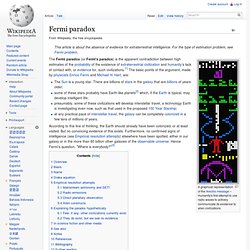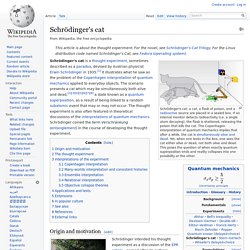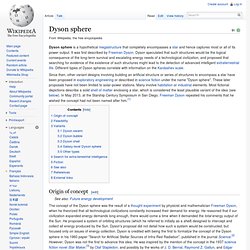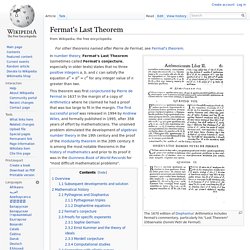

Fermi paradox. A graphical representation of the Arecibo message – Humanity's first attempt to use radio waves to actively communicate its existence to alien civilizations The Fermi paradox (or Fermi's paradox) is the apparent contradiction between high estimates of the probability of the existence of extraterrestrial civilization and humanity's lack of contact with, or evidence for, such civilizations.[1] The basic points of the argument, made by physicists Enrico Fermi and Michael H.

Hart, are: The Sun is a young star. There are billions of stars in the galaxy that are billions of years older;some of these stars probably have Earth-like planets[2] which, if the Earth is typical, may develop intelligent life;presumably, some of these civilizations will develop interstellar travel, a technology Earth is investigating even now, such as that used in the proposed 100 Year Starship;at any practical pace of interstellar travel, the galaxy can be completely colonized in a few tens of millions of years. Schrödinger's cat. Schrödinger's cat: a cat, a flask of poison, and a radioactive source are placed in a sealed box.

If an internal monitor detects radioactivity (i.e. a single atom decaying), the flask is shattered, releasing the poison that kills the cat. The Copenhagen interpretation of quantum mechanics implies that after a while, the cat is simultaneously alive and dead. Yet, when one looks in the box, one sees the cat either alive or dead, not both alive and dead. This poses the question of when exactly quantum superposition ends and reality collapses into one possibility or the other. Schrödinger's cat is a thought experiment, sometimes described as a paradox, devised by Austrian physicist Erwin Schrödinger in 1935.[1] It illustrates what he saw as the problem of the Copenhagen interpretation of quantum mechanics applied to everyday objects.
Origin and motivation[edit] Real-size cat figure in the garden of Huttenstrasse 9, Zurich, where Erwin Schrödinger lived 1921 – 1926. Schrödinger wrote:[1][10] Dyson sphere. Dyson sphere is a hypothetical megastructure that completely encompasses a star and hence captures most or all of its power output.

It was first described by Freeman Dyson. Dyson speculated that such structures would be the logical consequence of the long-term survival and escalating energy needs of a technological civilization, and proposed that searching for evidence of the existence of such structures might lead to the detection of advanced intelligent extraterrestrial life. Different types of Dyson spheres correlate with information on the Kardashev scale. Since then, other variant designs involving building an artificial structure or series of structures to encompass a star have been proposed in exploratory engineering or described in science fiction under the name "Dyson sphere".
These later proposals have not been limited to solar-power stations. Origin of concept[edit] Feasibility[edit] Variants[edit] Dyson swarm[edit] Dirac Theory. Next: Smaller EffectsUp: Everything You Always Wanted Previous: Kinetic Energy Correction The theory of Paul Dirac represents an attempt to unify the theories of quantum mechanics and special relativity.

That is, one seeks a formulation of quantum mechanics which is Lorentz invariant, and hence consistent with special relativity. For a free particle, relativity states that the energy is given by . Associating E with a Hamiltonian in quantum mechanics, one has If H and p are associated with the same operators as in Schrödinger theory, then one expects the wave equation This is known as the Klein-Gordan Equation. However, this creates a new problem. With this form of the Hamiltonian, the wave equation can be written In order for this to be valid, one hopes that when it is squared the Klein-Gordan equation is recovered. And are at least matrices and the wavefunction is a four-component column matrix. It turns out that equation 63 describes only a particle with spin 1/2. Where is small compared to. Fermat's Last Theorem. The 1670 edition of Diophantus' Arithmetica includes Fermat's commentary, particularly his "Last Theorem" (Observatio Domini Petri de Fermat).

In number theory, Fermat's Last Theorem (sometimes called Fermat's conjecture, especially in older texts) states that no three positive integers a, b, and c can satisfy the equation an + bn = cn for any integer value of n greater than two. This theorem was first conjectured by Pierre de Fermat in 1637 in the margin of a copy of Arithmetica where he claimed he had a proof that was too large to fit in the margin.
The first successful proof was released in 1994 by Andrew Wiles, and formally published in 1995, after 358 years of effort by mathematicians.